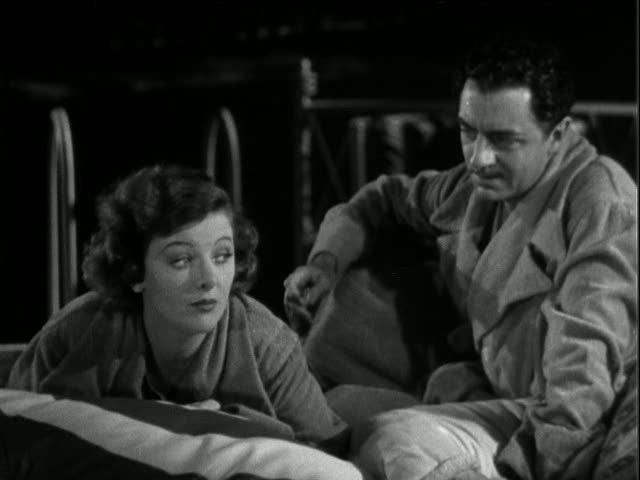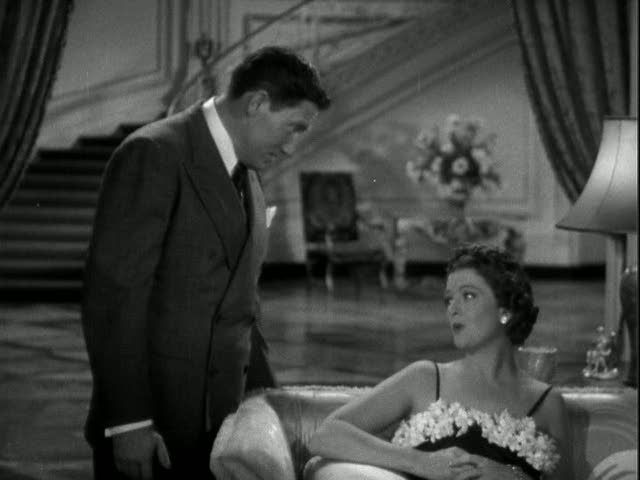
Libeled Lady provides an opportunity to see the unparalleled screen chemistry between William Powell and Myrna Loy outside of their six-film collaboration on the Thin Man films. This film, released two years after The Thin Man and just shortly before its first sequel After the Thin Man, offers a change from the comfort and wedded familiarity of Powell and Loy's Nick and Nora Charles. Here, the relationship between their characters is still in flux, still developing, and the film's greatest pleasure comes in watching them slowly work towards that easy interplay. When the film starts, there's a distance between them, a gap to be bridged by sheer charm and verbal seduction. Loy is Connie Allenbury, the globe-trotting daughter of a wealthy businessman and political hopeful (Walter Connolly). Allenbury had long been a rival of the newspaper the New York Evening Star, which accidentally prints a libelous and utterly untrue story about Connie, thus opening themselves up to a tremendous lawsuit. As a result, the paper's manic editor, Haggerty (Spencer Tracy), sends their best libel man to do anything he can to stop this lawsuit in its tracks, including compromising Connie so that her reputation really is ruined and the suit falls apart. This is, of course, Powell, as the compulsive and irresistible ladies' man Bill Chandler.
So the relationship between Connie and Chandler starts out as antagonistic. Connie suspects from the moment she meets him that Chandler is up to something — though her father adores this supposedly ace fisherman — and she maintains an icy remoteness that Chandler cannot crack. It's something to see the usually suave Powell utterly flummoxed, startled into silence by the mere fact that this woman will have nothing to do with him. She outsmarts him and steps neatly around his traps at every turn. From this hesitant beginning, though, the pair slowly begins developing towards their signature quick-witted repartee, with Powell's one-liners gliding effortlessly off of the ramp of Loy's pert, faux-wounded manners, her rolling eyes and puckered mouth. It's like watching the moment when Nick and Nora Charles first met and fell in love, when Nick's ragged charm and wit finally melted away the society ice queen's outer layers to find the playful girl inside.

Director Jack Conway doesn't have to do much with this pair besides get out of the way, and for the most part he does. The comic and romantic patter between Loy and Powell isn't particularly sharp or incisive — the script doesn't have the bounce or verve of the best Thin Man films — but the actors' warmth and obvious comfort with one another brings the characters to life. The film occasionally falters whenever it doesn't rely on the interplay of its leads, as in a lengthy and intermittently tedious sequence of fly fishing, with Chandler posing as a pro fisherman for the benefit of Connie and her father. To the extent that the scene relies on Powell's slapstick talents, it's a flop, because there's something deadening about seeing the dapper, self-possessed Powell trying to take a pratfall. He's not a physical comic, and it doesn't help that Conway's staging of Chandler's hapless attempts to catch a fish is flat and lifeless.
Thankfully, Powell and Loy do get admirable support from Tracy, and especially from Jean Harlow, as Haggerty's fiancée Gladys, who is used as a pawn in the plot to trip up Connie. Haggerty marries off Gladys to Chandler, keeping her hidden so that once Chandler compromises Connie, Gladys could appear to make it seem as though Connie were running around with a married man. Gladys provides comic relief throughout the film, a kind of crass, side-of-the-mouth counterpoint to Connie's prim sophistication. But in the final scene, she comes into her own, taking charge of the narrative by force. Her big moment is practically metafictional, a very self-conscious denial of the "happy ending" that seems to be developing in the final moments in the film; she sees the way this thing is heading, and she wants to make sure that she doesn't get left out of the Hollywood ending. As a result, the film seems to end twice: the narrative begins winding down and tying up loose ends only to be thrown into confusion again by Gladys at the last minute. The effect is sort of like those old Looney Tunes cartoons where the characters, conscious of their status in a fictional artifice, try desperately to exert some control over the direction of the story. Like Daffy in Duck Amuck, the cartoonish Gladys won't allow herself to be pushed around by some writer without putting up a fight, and her big speech winds up questioning not only the dictates of the story but the assumptions of the audience, who were probably only too willing to accept a "happy ending" for the charming, witty, upper-class characters while the vulgar, urban dame gets a raw deal. It's a great moment, subtly undercutting the assumptions about class underlying so many Hollywood romances and comedies. If the rest of the film is rarely so sophisticated or complex, though, it's still often funny and light and enjoyable, making this a fluffy entertainment that at the last moment hints at something more.
Yes I agree that the fly-fishing squence is out of place--didn't Howard Hawks lift this scene for MAN'S FAVORITE SPORT? In any case the interplay by the leads is as you say sparkling, and the film is a classy entertainment where the actors shine, especially Jean Harlowe. This film has a high quotient of sexual chemistry.
ReplyDeleteAs always, a review of depth and insight.
I still have to see Man's Favorite Sport as I continue to dig into late Hawks, but I wouldn't be surprised. I did think of that film during the very awkward fly-fishing scenes here. I agree about Harlow, who's a lot of fun here, and unexpectedly dominates the denouement, stealing the show at the last moment.
ReplyDelete